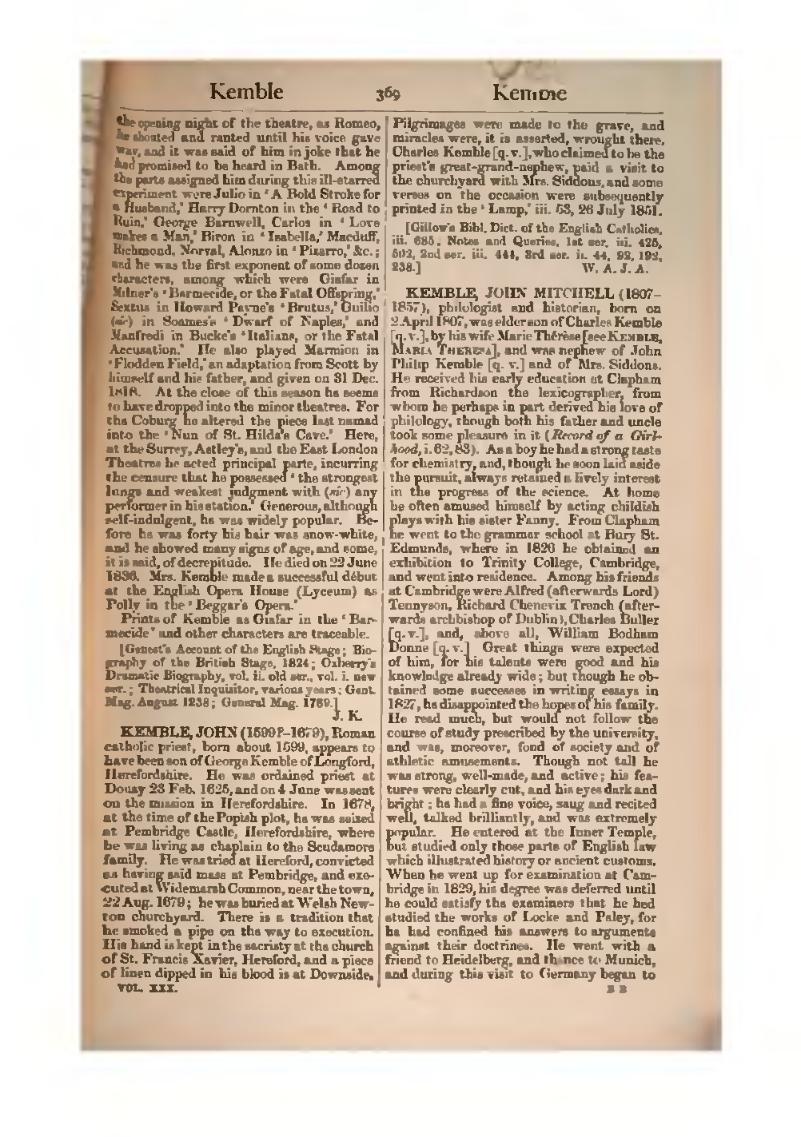the opening night of the theatre, as Romeo, he shouted and ranted until his voice gave way, and it was said of him in joke that he had promised to be heard in Bath. Among the parts assigned him during this ill-starred experiment were Julio in ‘A Bold Stroke for a Husband,’ Harry Dornton in the ‘Road to Ruin,’ George Barnwell, Carlos in ‘Love makes a Man,’ Biron in ‘Isabella,’ Macduff, Richmond, Norval, Alonzo in ‘Pizarro,’ &c.; and he was the first exponent of some dozen characters, among which were Giafar in Milner's ‘Barmecide, or the Fatal Offspring,’ Sextus in Howard Payne's ‘Brutus,’ Guilio (sic) in Soames's ‘Dwarf of Naples,’ and Manfredi in Bucke's ‘Italians, or the Fatal Accusation.’ He also played Marmion in ‘Flodden Field,’ an adaptation from Scott by himself and his father, and given on 31 Dec. 1818. At the close of this season he seems to have dropped into the minor theatres. For the Coburg he altered the piece last named into the ‘Nun of St. Hilda's Cave.’ Here, at the Surrey, Astley's, and the East London Theatres he acted principal parts, incurring the censure that he possessed ‘the strongest lungs and weakest judgment with (sic) any performer in his station.’ Generous, although self-indulgent, he was widely popular. Before he was forty his hair was snow-white, and he showed many signs of age, and some, it is said, of decrepitude. He died on 22 June 1836. Mrs. Kemble made a successful début at the English Opera House (Lyceum) as Polly in the ‘Beggar's Opera.’
Prints of Kemble as Giafar in the ‘Barmecide’ and other characters are traceable.
[Genest's Account of the English Stage; Biography of the British Stage, 1824; Oxberry's Dramatic Biography, vol. ii. old ser., vol. i. new ser.; Theatrical Inquisitor, various years; Gent. Mag. August 1836; General Mag. 1789.]
KEMBLE, JOHN (1599?–1679), Roman catholic priest, born about 1599, appears to have been son of George Kemble of Longford, Herefordshire. He was ordained priest at Douay 23 Feb. 1625, and on 4 June was sent on the mission in Herefordshire. In 1678, at the time of the Popish plot, he was seized at Pembridge Castle, Herefordshire, where he was living as chaplain to the Scudamore family. He was tried at Hereford, convicted as having said mass at Pembridge, and executed at Widemarsh Common, near the town, 22 Aug. 1679; he was buried at Welsh Newton churchyard. There is a tradition that he smoked a pipe on the way to execution. His hand is kept in the sacristy at the church of St. Francis Xavier, Hereford, and a piece of linen dipped in his blood is at Downside. Pilgrimages were made to the grave, and miracles were, it is asserted, wrought there. Charles Kemble [q. v.], who claimed to be the priest's great-grand-nephew, paid a visit to the churchyard with Mrs. Siddons, and some verses on the occasion were subsequently printed in the ‘Lamp,’ iii. 53, 26 July 1851.
[Gillow's Bibl. Dict. of the English Catholics, iii. 685; Notes and Queries, 1st ser. iii. 425, 502, 2nd ser. iii. 444, 3rd ser. ii. 44, 92, 192, 238.]
KEMBLE, JOHN MITCHELL (1807–1857), philologist and historian, born on 2 April 1807, was elder son of Charles Kemble [q. v.], by his wife Marie Thérèse [see Kemble, Maria Theresa], and was nephew of John Philip Kemble [q. v.] and of Mrs. Siddons. He received his early education at Clapham from Richardson the lexicographer, from whom he perhaps in part derived his love of philology, though both his father and uncle took some pleasure in it (Record of a Girlhood, i. 62, 83). As a boy he had a strong taste for chemistry, and, though he soon laid aside the pursuit, always retained a lively interest in the progress of the science. At home he often amused himself by acting childish plays with his sister Fanny. From Clapham he went to the grammar school at Bury St. Edmunds, where in 1826 he obtained an exhibition to Trinity College, Cambridge, and went into residence. Among his friends at Cambridge were Alfred (afterwards Lord) Tennyson, Richard Chenevix Trench (afterwards archbishop of Dublin), Charles Buller [q. v.], and, above all, William Bodham Donne [q. v.] Great things were expected of him, for his talents were good and his knowledge already wide; but though he obtained some successes in writing essays in 1827, he disappointed the hopes of his family. He read much, but would not follow the course of study prescribed by the university, and was, moreover, fond of society and of athletic amusements. Though not tall he was strong, well-made, and active; his features were clearly cut, and his eyes dark and bright; he had a fine voice, sang and recited well, talked brilliantly, and was extremely popular. He entered at the Inner Temple, but studied only those parts of English law which illustrated history or ancient customs. When he went up for examination at Cambridge in 1829, his degree was deferred until he could satisfy the examiners that he had studied the works of Locke and Paley, for he had confined his answers to arguments against their doctrines. He went with a friend to Heidelberg, and thence to Munich, and during this visit to Germany began to
